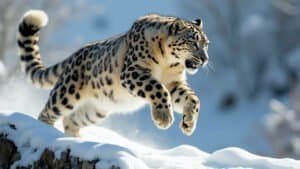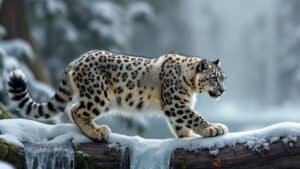Snow leopards live high in the mountains where it’s snowy, cold, and full of cliffs. To survive there, they need paws built for action. So, what are the key characteristics of a snow leopard’s paw and how do they aid in its movement?
Their paws work like snowshoes, helping them stay on top of deep snow. Covered in thick fur, the paws keep them warm and steady as they walk, jump, and hunt. In this article, you’ll learn how their paws help with grip, balance, and silence on rocky and snowy ground, and how they differ from other big cats.
Snow Leopard Paw Adaptations for Mountain Movement

High up in the Himalayas and Central Asian mountains, snow leopards live where most animals can’t survive. The ground is rocky, the slopes are steep, and snow covers the land for months. Moving in this tough terrain isn’t easy, but snow leopards manage it with help from one special feature—their paws.
These big, wide, and furry feet do more than just help them walk. They work like built-in snowshoes, giving them the balance, grip, and warmth needed to move fast and quietly through snow and rock.
How Paw Size Supports Snow Navigation
Snow leopards have some of the largest paws in the cat family when compared to body size. Their front paws can measure up to four inches long and over three inches wide. This large surface area spreads the animal’s weight, letting it walk on soft snow without sinking too deep.
It’s similar to how snowshoes help people walk across powdery snow without falling through. This ability is very helpful when the snow leopard needs to sneak up on prey without making noise or leaving deep tracks. The large paws also make it easier to move quickly, even in places where the snow is deep and fluffy.
Ever wondered how animals run across snow without falling in? For snow leopards, it’s all in the paws.
The Role of Fur in Paw Insulation and Grip
One of the most impressive features of a snow leopard’s paw is the thick fur that covers it. Unlike other big cats, snow leopards have fur not just on top but also underneath the paw. This layer keeps their feet warm and protects them from the frozen ground.
But that’s not all. The fur also adds grip, helping them keep steady when they step on slippery rocks or ice. This built-in insulation works like warm socks and rough treads all in one. Even the space between the toes is packed with fur, which helps trap heat and adds padding.
Want to see more about how fur helps snow leopards survive the cold? The Snow Leopard Trust offers great information on these adaptations.
How Snow Leopards Use Their Paws as Natural Snowshoes
Snow leopards don’t wear shoes, but their paws do the job just as well. Their large size and furry surface turn each foot into a snowshoe. This keeps them from sinking in snow and helps them move more smoothly.
When they stalk prey or patrol their territory, this quiet movement makes a big difference. These cats are also known to leap across gaps and rocky cliffs. Their paws absorb shock and help them land safely. This is important when hunting or moving quickly over steep terrain. The design of their paws lets them go almost anywhere—quietly, safely, and with less effort.
What other wild cat can walk in deep snow, jump across cliffs, and land like a pro? That’s the snow leopard’s secret weapon—its paw.
Physical Features of Snow Leopard Paws

The snow leopard’s paws are not just big and furry—they’re designed with fine-tuned details that help the animal survive in some of the harshest places on Earth.
Everything from the shape of the pads to the structure of the claws plays a role in movement, warmth, and hunting. These features don’t just happen by chance; they’ve evolved to support life in steep, frozen terrain. Let’s take a closer look at how their paws are built for the job.
Measurements of Paw Pads and Surface Area
Snow leopards have front paw pads that measure about 3.5 to 4 inches long and 2.8 to 3.1 inches wide. That might not sound huge, but for their body size, these paws are oversized compared to other big cats. The large size increases the surface area that touches the ground.
This matters a lot when walking on snow. With more surface to stand on, their body weight spreads out, which means they don’t sink as much. It’s the same idea behind wearing snowshoes. This shape also helps them stay balanced when climbing or jumping. Even on steep cliffs, their paws give them the right grip and support to stay steady.
Why would a big cat need such wide feet? It’s not just about size—it’s about how the size helps them survive.
The Structure and Shape of the Paw Pads
Each snow leopard paw has soft pads underneath that act like natural shock absorbers. These pads help the animal walk softly and silently, which is important when stalking prey.
But these pads are not bare. They’re surrounded by fur and have a slightly rough surface, which helps grip slippery ground. Between the toes, the fur is thick, giving extra protection against cold and adding grip when the animal spreads its toes while walking or landing from a jump. The paw shape allows the toes to spread wide when needed, giving better balance on uneven ground.
Want to explore more about how this shape helps them live on snowy cliffs? The WWF Snow Leopard Facts page explains these traits well.
Claw Mechanics and Their Role in Movement
Like other big cats, snow leopards have retractable claws. These claws stay hidden inside the paw when not in use, which keeps them sharp. When the cat needs them—like while climbing, hunting, or jumping—the claws pop out to grab or hold onto surfaces.
The claws help the leopard grip rocky cliffs and hold onto prey during a chase. Because the claws are protected most of the time, they don’t get worn down easily. This makes them more effective when the cat really needs them. The combination of sharp claws and wide, padded paws means the snow leopard can climb, pounce, and move across rough ground with ease.
How do you stay steady on a cliff or icy rock? For snow leopards, it’s sharp claws and padded paws working together.
How Snow Leopard Paws Enhance Hunting and Stealth

Hunting in the mountains isn’t just hard—it’s dangerous. Snow leopards must sneak up on fast, alert animals across rocks, snow, and steep slopes. That’s where their paws come in. These powerful feet don’t just carry them from place to place.
They help the snow leopard stay silent, balanced, and quick. Every part of the paw plays a role in hunting, from the padded soles to the hidden claws. Let’s explore how these natural tools help the snow leopard catch its prey.
Silent Movement Over Snow and Rocks
Snow leopards are known as “ghosts of the mountains” because of how quietly they move. Their large, fur-covered paws make this possible. The thick fur underneath softens each step, so there’s little sound when they walk across snow or gravel.
The wide pads help the cat avoid stepping on sharp or noisy surfaces. By spreading out their weight, they don’t crunch through snow like other animals. Instead, they glide almost silently. This gives them a better chance to get close to prey before launching an attack.
How close can a snow leopard get before it’s seen or heard? Closer than you might think—thanks to its silent paws.
Traction and Stability on Uneven Terrain
Hunting in the mountains means chasing prey across rocky slopes and icy ledges. The snow leopard’s paws provide the grip it needs to stay upright and move fast. The rough paw pads and fur between the toes help the animal hold onto slippery or loose surfaces.
Whether running uphill or turning sharply on rock, these paws keep it from falling. The wide shape gives it more balance, and the claws add extra traction when needed. The ability to hold onto surfaces firmly is a big reason the snow leopard can chase mountain goats and other animals in extreme places.
What kind of hunter can run up a cliff without slipping? One with paws made for mountain grip.
Landing and Jumping with Precision
Snow leopards are amazing jumpers. They can leap more than 30 feet in one bound, often across cliffs or over deep snow. Landing safely after such jumps takes more than strong legs—it takes the right paws. The large, padded paws work like cushions, absorbing the shock of landing.
Their shape also helps the leopard stay steady when hitting the ground, even if it’s rocky or uneven. This ability lets them leap from rock to rock while chasing prey or escaping danger. The paws also help launch the animal into the air by giving it the push it needs from a stable base.
Can your feet help you jump the length of a school bus? Snow leopards do it often—with help from powerful, padded paws.
Want to learn more about how snow leopards survive the wild cliffs? The Snow Leopard Conservancy has great facts about how they move and hunt.
Snow Leopard Paws vs Other Big Cats

When it comes to big cats, every species has paws built for its environment. Tigers need strength for jungles, lions need speed for savannas, and cheetahs need traction for sprints. But snow leopards live where it’s cold, steep, and snowy.
Their paws are completely different—built to survive the mountains. To understand just how special their paws are, it helps to compare them with the paws of other big cats. The differences tell a story about how each animal fits into its habitat.
Morphological Differences in Pad Design
Snow leopard paw pads are noticeably larger and wider than those of most other big cats. A leopard or tiger of similar size has smaller paws relative to body weight. This difference gives snow leopards more surface area per step. It helps them walk on snow without sinking.
Other big cats don’t face deep snow often, so they don’t need this feature. Also, snow leopards have more rounded pads, shaped to match rocky and uneven mountain surfaces. The structure helps them balance on narrow ledges and steep hillsides where precision matters with every step.
Why do snow leopards have such big feet while tigers don’t? It all comes down to the ground they walk on.
Fur Density and Thermal Adaptation Comparisons
One of the biggest differences between snow leopards and other big cats is the fur on their feet. Snow leopards have dense fur covering their entire paw, including underneath and between the toes.
This is rare in the cat family. For example, lions and cheetahs have bare paw pads, exposed to the ground. Snow leopards need insulation from cold, icy ground, which is why fur grows even between their toes. This extra layer keeps their feet from freezing and adds grip on ice or snow. It’s like wearing fur-lined boots.
Which cat walks on snow with built-in boots? The snow leopard, with paws made to stay warm in deep freeze.
Locomotion Adaptations for Cold Environments
Moving in cold, snowy mountains means dealing with slippery, uneven, and frozen surfaces. Snow leopard paws handle these challenges better than those of most other big cats. Their paws help them leap across rocks, stay balanced on icy slopes, and land smoothly after long jumps.
The broad pads, thick fur, and powerful claws all work together. By contrast, a lion or leopard might struggle in the same environment. Their paws aren’t designed to spread weight or insulate from cold. This is why snow leopards can live high up in places that stay frozen for months.
What lets one big cat survive where others can’t? It starts with the paws—and snow leopards have some of the best-designed feet in the animal kingdom.












